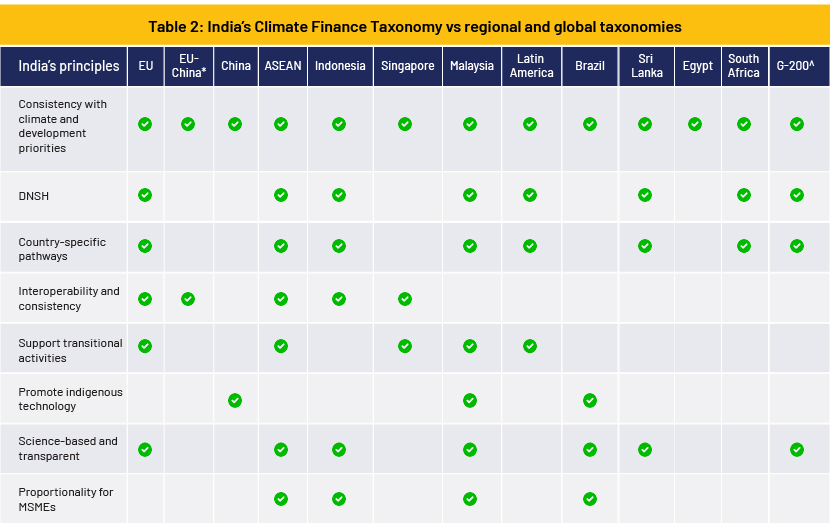Published on June 13, 2025 by Ramesh Dharanipathy
The Indian government recently published a draft “Framework of India’s Climate Finance Taxonomy”, aiming to direct investments to hard-to-abate sectors to support the development of low-emission production technologies, large-scale deployment of mature climate technologies and building of domestic expertise for a gradual transition to low-emission pathways. The focus will initially be on the iron, steel and cement sectors, with periodic reviews to incorporate emerging requirements; in the future, it intends to include other hard-to-abate sectors such as fertiliser and aluminium. The Ministry of Finance has released this draft for public consultation, and it will remain open until 25 June 2025. The department intends to review all feedback before finalising the framework. This draft marks a significant step in defining the climate finance taxonomy in India, laying the groundwork for more structured green investments across sectors.
This blog aims to delve into the following aspects of sustainable or green taxonomies:
-
Why are taxonomies needed?
-
How is the effectiveness of a taxonomy assessed?
-
A comparison of India’s Climate Finance Taxonomy with the EU Taxonomy and regional and other taxonomies
Why taxonomies?
Taxonomies play a key role in a number of contexts, catering to different stakeholders. Its usability depends on the structure and integration within the sustainable finance landscape. By providing a structured framework for classifying and assessing sustainability activities, taxonomies facilitate better decision-making for businesses, investors, regulators and policymakers. They enable users to identify sustainable practices, enhance transparency and promote accountability within the financial system. Overall, a well-designed taxonomy guides allocation of capital to meet sustainability goals. Taxonomies help with the following aspects[1]:
-
Purpose and uses: Taxonomies provide a consistent framework and common language for stakeholders such as investors, lenders, businesses and governments.
-
Guidance for organisations: Taxonomies clarify what companies and projects must do to qualify for sustainable funding.
-
Risk management and strategic planning: Taxonomies serve as benchmarks for assessing risks such as asset impairment, stranded assets and greenwashing.
-
Turning commitments into action: Taxonomies translate broad pledges (e.g., the Paris Agreement) into concrete targets and policies.
-
Context-specific design: Taxonomies should be tailored to the economic, social and environmental conditions of a region/country.
How is the effectiveness of a taxonomy assessed?
The main purpose of a taxonomy is to effectively channel investments to environmentally sustainable activities through a clear classification of sustainable activities, establishing robust criteria (preferably science-based criteria), incorporating Do No Significant Harm (DNSH) principles and minimum social safeguards; it should also be interoperable with existing taxonomies. Mandating taxonomy disclosure also plays an important role, as it promotes transparency and accountability among stakeholders. Furthermore, taxonomies should be adaptable, enabling integration of new scientific findings and technological advancements to ensure their relevance and effectiveness in promoting sustainable investment practices. The following are details that help assess the effectiveness of taxonomies.
-
Clear classification: Any implementable taxonomy starts with a clear definition of what constitutes sustainable activity. The EU Taxonomy is the best example; it outlines the six environmental objectives. Those taxonomies that are limited to specific activities and include only a very few sectors reduce their usefulness.
-
Criteria and thresholds: The taxonomy should be founded on science-based technical screening criteria to assess sustainable activity. This should include measurable thresholds for emissions, and their environmental impact, based on the latest scientific evidence.
-
Do No Significant Harm (DNSH) and Minimum Social Safeguards (MSS): Any sustainable activity could meet the specific standards of a taxonomy, but it should not cause harm to other environmental objectives. This is to prevent unintended consequences while promoting sustainability. Although a taxonomy is developed to assess environmental objectives, it should also comply with minimum social standards and ethical practices, such as human rights, tax compliance, fair competition and anti-corruption and anti-bribery practices.
-
Accessibility: The taxonomy should be made public and should be based on transparent methodologies, so as to build trust and encourage broader adoption and acceptability among investors, businesses and regulators.
-
Interoperability: Taxonomies should be consistent across sectors and should broadly align with national climate targets, nationally determined contributions (NDCs), net-zero targets and international standards. Interoperability is crucial to investors who have global exposure and companies that operate in different economies, ensuring clarity and consistency in sustainable practices.
-
Mandatory reporting: Taxonomy disclosures should be supported by mandatory disclosure requirements, enabling investors and regulators to verify the sustainability claims of activities and companies.
-
Flexibility: The taxonomy must be adaptable, incorporating ongoing scientific advancements and market changes. Regular reviews and updates are essential to ensure it remains relevant and effective over time.
A comparison of India’s Climate Finance Taxonomy with the EU Taxonomy and regional and other taxonomies
The EU taxonomy for sustainable finance is widely regarded as a benchmark for regulatory clarity and environmental ambition, influencing many global frameworks including India’s evolving taxonomy. It is characterised by its detailed technical criteria that align with the EU's ambitious climate and environmental targets.
In contrast, India's Climate Finance Taxonomy is still in draft form and aims to mitigate greenwashing by establishing clear definitions for climate-relevant activities along with measurable thresholds to enhance transparency. However, it currently lacks the binding enforcement and thorough verification mechanisms found in the EU framework, reflecting India's developing-market context and gradual approach to sustainable finance regulation. Notably, India's Taxonomy is in line with regional ASEAN efforts that seek to harmonise diverse national methodologies, while taxonomies in Latin America, South Africa and Egypt are likely to reflect their unique national priorities while adhering to global taxonomy principles.
Consequently, the EU Taxonomy stands out as a more advanced and robust system specifically designed to address greenwashing, whereas India's Taxonomy represents an evolving framework that emphasises clarity and accountability. India's approach is expected to strengthen its safeguards against greenwashing as it matures. Refer to Table 1, which compares all the aspects of the EU Taxonomy with India’s framework, and Table 2, which compares India’s Taxonomy with regional and global taxonomies.
| Aspect | EU Taxonomy for sustainable activity | India’s Climate Finance Taxonomy |
| Status | Legally-binding regulations since 2020 | Draft framework, non-binding guiding document (2025) |
| Climate goals | Carbon neutrality by 2050, intermediate (2030) targets | Net zero by 2070, interim (2030) targets |
| Context | Designed for developed economies with mature regulatory frameworks and ambitious climate targets aligned with the Paris Agreement | Tailored to each country, balancing climate ambitions with economic growth, energy access and affordability |
| Classification categories | Environmentally sustainable activities with six objectives | Climate-supportive and transition-supportive activities |
| Environmental objectives |
|
|
| Performance thresholds | Technical screening criteria (TSC) with stringent thresholds | Hybrid approach integrates qualitative and quantitative criteria. It will initially use qualitative aspects, with plans to gradually introduce quantitative emission thresholds |
| Do No Significant Harm (DNSH) | Explicit DNSH principle required for all activities | Implicit in principles but less explicitly defined than the EU Taxonomy |
| Social safeguards | Minimum social safeguards mandated alongside environmental objectives | Recognised but less detailed; MSMEs have simplified criteria |
| Sector focus | Broad sector coverage with detailed annexures for each sector | Hard-to-abate sectors prioritised initially (iron, steel, cement) |
| Adaptation emphasis | Included as one of six environmental objectives | Strong focus on adaptation and resilience building |
| Regulatory approach | Strict, detailed, mandatory disclosure requirements | Flexible, evolving, phased adoption |
| MSME inclusion | Not specially highlighted | Specific considerations with simplified criteria |
| Verification and enforcement | TSC reviewed by EU and expert panels | No formal verification mechanism yet; framework for guidance |
| Scope of greenwashing addressed | Focused on false claims, untrustworthy promises and non-transparent disclosures | Focused on clarity and accountability to prevent misallocation of funds |
| Investor confidence focus | High priority; taxonomy aims to build trust and avoid misleading claims | Aims to enhance investor confidence, especially in emerging sectors and MSMEs |

Overall, India's Climate Finance Taxonomy serves as a strategic framework that follows a hybrid approach (integrating both qualitative and quantitative methods), considering specific sectors while adhering to principles suited to the nation's developmental and climatic needs. Its primary goal is to direct investments towards sustainable and resilient economic initiatives, mitigate the risk of greenwashing and facilitate a fair transition across sectors, including micro, small and medium-size enterprises (MSMEs). By enhancing transparency and boosting investor confidence, this framework aims to strengthen India's green finance landscape.
How Acuity Knowledge Partners can help
Acuity Knowledge Partners deploy ESG and sustainability specialists through flexible engagement models to provide a vast array of capabilities to effectively assist clients in a number of critical areas. These specialists are well versed in the intricacies of environmental, social and governance factors and are able to provide tailored insights that align with a client’s strategic objectives. With such comprehensive skillsets, our specialists are invaluable for any organisation seeking to strengthen its ESG and sustainability research and support it in investment decision-making.
Services we offer:
-
End-to-end support with SFDR reporting
-
EU Taxonomy assessment of investee companies
-
Climate risk and opportunity assessment
-
Climate change scenario analysis and stress testing
-
Quantifying financial impacts of climate risks
-
Evaluating the efficacy of decarbonisation plans
-
Evaluating Scope 3 emissions, particularly financed emissions
-
Preparing reports for the Task Force on Climate-Related Financial Disclosures (TCFD)
-
Support with sustainability and climate reporting
-
Conducting green, social and sustainable bond impact assessment
-
Climate risk and vulnerability assessments, including asset impact and impairment modelling
-
Single- and double-materiality assessments
-
ESG and climate maturity assessments
-
SDG mapping and impact assessment of investee companies
References:
-
[1] https://www.adb.org/sites/default/files/institutional-document/1007506/apcr2024bp-channeling-sustainable-finance-role-taxonomies.pdf
-
India Releases Draft Climate Finance Taxonomy to Drive Capital to Net Zero Goals – ESG Today
-
India Unveils Draft Climate Finance Taxonomy to Boost Green Capital Flows – ESG News
Tags:
What's your view?
About the Author
Ramesh Dharanipathy has been with Acuity Knowledge Partners for 13 years working in the areas of ESG, Sustainability, climate change and investment research. He has acquired extensive experience in various aspects of ESG, sustainability, and climate change, including conducting climate-related risk and opportunity assessments, performing ESG and climate maturity evaluations, and mapping Sustainable Development Goals (SDGs) alongside impact assessments for investee companies. His expertise also encompasses comprehensive support for SFDR reporting, EU Taxonomy assessments, double-maturity evaluations, ESG benchmarking and analysis, and developed ESG – related methodology documents. Additionally, he is involved in assessing the impact of green, social, and sustainable bonds while quantifying the financial implications of climate risks...Show More
Like the way we think?
Next time we post something new, we'll send it to your inbox










